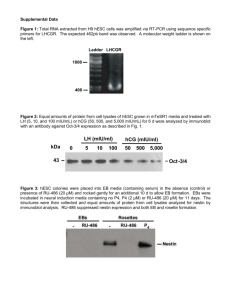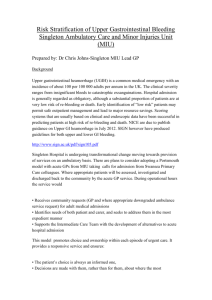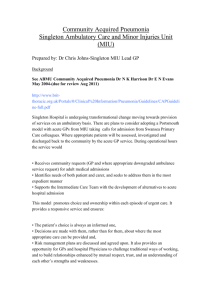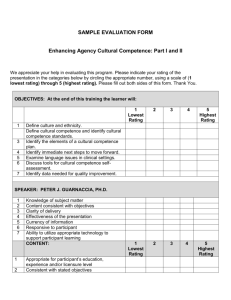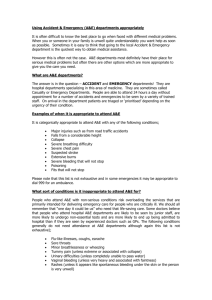46_BOD_Urgent Care Quality Review FINAL
advertisement
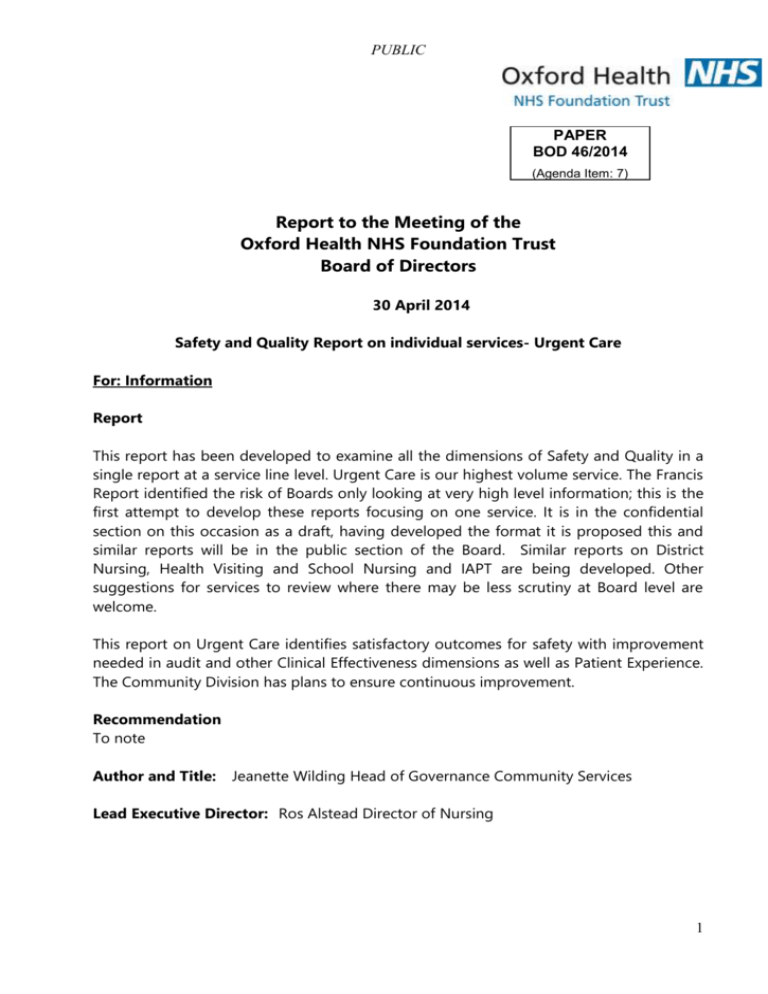
PUBLIC PAPER BOD 46/2014 (Agenda Item: 7) Report to the Meeting of the Oxford Health NHS Foundation Trust Board of Directors 30 April 2014 Safety and Quality Report on individual services- Urgent Care For: Information Report This report has been developed to examine all the dimensions of Safety and Quality in a single report at a service line level. Urgent Care is our highest volume service. The Francis Report identified the risk of Boards only looking at very high level information; this is the first attempt to develop these reports focusing on one service. It is in the confidential section on this occasion as a draft, having developed the format it is proposed this and similar reports will be in the public section of the Board. Similar reports on District Nursing, Health Visiting and School Nursing and IAPT are being developed. Other suggestions for services to review where there may be less scrutiny at Board level are welcome. This report on Urgent Care identifies satisfactory outcomes for safety with improvement needed in audit and other Clinical Effectiveness dimensions as well as Patient Experience. The Community Division has plans to ensure continuous improvement. Recommendation To note Author and Title: Jeanette Wilding Head of Governance Community Services Lead Executive Director: Ros Alstead Director of Nursing 1 PUBLIC Urgent Care Quality Review The Urgent Care Service consists of Out of Hours (OOH), Minor Injuries Units (MIU) and Hospital at Home. It is a high volume service with an average across all of the services in the service profile of 15-16,000 contacts per month; with out of hours having the largest volume at around 12,000 episodes (each episode includes all aspects of a patients contact telephone and face to face). The nature of the service holds inherent risks as there consultations are generally undertaken with minimal past medical history available via systemone which does hold some core interface information with the patients GP. 1. 1.1 Safety Incidents YTD trend Urgent care is the 3rd largest reporter of incidents with 127 reported YTD which is 4% of the Divisional. 1.2 Incidents – top 3 categories April-December 2013 Cause Communication/confidentiality Health Medication Number 36 22 17 2 PUBLIC 1.3 Incident and level of harm Q3 Incidents Oct-Dec13 1. No Injury/ No Property Damage 2. Minor Injury/ Minor Property Damage 3. Moderate Injury/ Moderate Property Damage 4. Major Injury/ Severe Property Damage 5. Death Grand Total Number 23 14 Percentage Trust wide 55% 48% 33% 39% 4 10% 13% 0 1 42 0% 2% <1% <1% The data demonstrates there is a good culture of reporting as the service is reporting good levels of incidents where no harm was experienced. Clearly the nature of the service there will be patient deaths reported, these are all investigated to ensure there were no concerns with the care provided by OH and should any concern be indicated the death would be escalated in accordance with SIRI policy. 1.4 SIRI’s and High Risk Incidents The service has experienced no SIRI’s to end of quarter 3 There were 4 avoidable high risk incidents reported in Q3 and initial investigations were undertaken and these identified learning points along the following themes. Safeguard Ref Communication Discharge Scheduling/ Prioritisation Documentation Training Medication IT Communication with other services 25817 24508 21830 21901 One of the key interfaces with other providers is the 111 service and any concerns identified in this interface is jointly reviewed via the specific governance arrangements that are in place between these services and is led by the CCG clinical governance lead for urgent care. 3 1.5 PUBLIC Safety thermometer results Hospital @ Home Unsurprisingly due to the nature of the Hospital @ Home service, where care is provided at home to avert hospital admission, that catheters and UTI feature highly in this point prevalence audit. 2. 2.1 Patient Experience Results against the 4 Trust wide questions All patient surveys in the Trust feature these 4 questions. These are results AprDec 13. Overall the service experience high service user satisfaction with the exception of waiting times for the MIU service. MIU mean rating 97%; 1213 mean rating 94% (Div 85%) OOH mean rating 86%; 1213 mean rating 91% 4 PUBLIC MIU mean rating 96%; 1213 mean rating 97% (Div 83%) OOH mean rating 85%; 1213 mean rating 98% MIU mean rating 96%; 1213 mean rating 93% (Div 90%) OOH mean rating 91%; 1213 mean rating 86% MIU mean rating 93%; 1213 mean rating 92% (Div 88%) OOH mean rating 87%; 1213 mean rating 84% 5 PUBLIC 2.2 Family & Friends Test This national survey is given to all MIU discharges, asking whether they would recommend the service to others. Response Rate Oct 2013 Nov 2013 Dec 2013 Total YTD Number of Discharges/ Face to Face Contacts (YTD) % Response Rate Witney Minor Injuries Unit 137 115 158 861 8,378 10.3 Abingdon Minor Injuries Unit 75 55 69 481 11,771 4.1 Henley Minor Injuries Unit 9 12 5 88 4,209 Overall CH and MIU 241 198 257 1575 22,089 2.1 7.5% Results Area Witney Minor Injuries Unit Abingdon Minor Injuries Unit Henley Minor Injury Unit Extremely likely 639 Likely Unlikely 191 Neither likely nor unlikely 15 7 Extremely unlikely 9 Grand Total 861 268 113 35 26 39 481 76 11 1 87 Net Promoter Score Number of Responses April 2013 May 2013 June 2013 July 2013 Aug 2013 Sept 2013 Oct 2013 Nov 2013 Dec 2013 YTD 191 20 73 117 223 171 221 182 232 1430 % of respondents who said extremely likely to recommend 139/191 = 72.8% 16/20 = 80% 48/73 = 65.8% 75/117 = 64.1% 151/223 = 67.7% 113/171 = 66.1% 149/221 = 67.4% 128/182 = 70.3% 164/232 = 70.7% 1261/1430=88.2% % of respondents who would not recommend (neither likely or unlikely, unlikely and extremely unlikely 9/191 = 2.6% 0/20 = 0% 12/73 = 16.4% 17/117 = 14.5% 23/223 = 10.3% 13/171 = 7.6% 20/221 = 9.1% 20/182 = 11.0% 18/232 = 7.8% 132/1430=9.2% Net promoter score 70.2 80 49.4 49.6 57.4 58.5 58.3 59.3 62.9 79 6 PUBLIC Sample comments from FFT cards Oct-Dec (Entries in capitals came from electronic kiosk) Henley Efficient, fast and friendly. Henley The staff were very helpful and showed real concern about my injury. Witney Excellent service, quick friendly and professional. Witney Abingdon Friendly staff, clean environment, efficient service. FANTASTIC DOCTOR EXPLAINING IN DETAIL AND IN PLAIN OLD ENGLISH Abingdon LOVELY NURSES, THOROUGH AND GOOD WITH ALL AGES Abingdon POOR SIGNAGE MADE IT HARD TO FIND. POOR TIMEKEEPING. Obnoxious staff on reception, trying to get rid of us, rather than dealing with us. Witney The vast majority of comments were positive, as usual. All Henley MIU returns in Q3 were likely or extremely likely to recommend. Nationally the aim is to achieve a 15% response rate. MIUs received a 5.9% response rate in Q3, up from 4.7% in Q2 (equivalent national response rate reported by A&E = 8%). The service is reviewing how it can try and increase the response rate by patients, this includes improved patient feedback in waiting areas on how the service values patient feedback and what has changed as a result of their feedback and also when the postcards are given to the patients in their treatment pathway. The MIU’s are unscheduled clinics and there demand is not easily predicted, where trends have indicated peaks in demand staffing schedules have been mapped to these however there can be unexpected peaks and therefore the service is considering a pilot to offer patients who do not require an immediate consultation the offer of an appointed consultation at a time when lower demand is predicted to reduce patient waiting time. There is also a tension in that out of hours patients, which is an appointed service, wait in the same waiting area go into their appointments and there can be a perceptual problem so the service has developed a leaflet explaining the service differences and why there are differing waiting times. Also the service managers regularly reminding staff to keep the waiting time boards up to date with current waiting times to keep patients correctly informed. 7 PUBLIC 2.3 Complaints and Compliments Urgent Care received 24 compliments Oct-Dec 13 Service GP Out of Hours & MIU, Abingdon GP Out of Hours & MIU, Banbury GP Out of Hours & MIU, Bicester GP Out of Hours & MIU, East Oxford Health Centre GP Out of Hours & MIU, Henley GP Out of Hours & MIU, Witney Urgent Care Hospital @ Home Abingdon Oct 0 0 0 0 0 0 3 Nov 0 0 0 0 0 0 3 Dec 4 1 0 0 2 4 7 Complaints This is a very high volume service with an average of 15-16,000 contacts/episodes per month all services under the urgent care heading. Eighteen complaints were received between Jan 12 and Dec 13; of these 5 had elements that were upheld. The complaints raised detailed concerns with regards. 3. 3.1 Clinical Effectiveness There are 11 audits scheduled during 1314 that cover Urgent Care. Audit NQR4: Telephone Triage (OOH) CG160: Feverish Illness In Children Antimicrobial Prescriptions Compliant With Commissioner’s Guidelines PGD Scheduled Complete Rating Good Summary of issues Positive results, with a slight issue in the area of recording appropriate history TBA To focus on areas that scored poorly in 1213 31/3/14 31/12/13 TBA TBA Complete Requires Improvement 68% of antimicrobial prescriptions adhere to guidelines (CCG's KPI=55%). For high risk prescriptions, the figure was only 25%. Action plan in place Complete Requires Improvement A very high percentage of all PGDs are signed and there is an excellent audit trail for these signatures. All PGDs are up to date with review dates in place. Good (80-94%) adherence in documentation of a patient’s past medical history, drug history and a diagnosis, the frequency and duration of the drug given and general safety netting advice. There is a higher than acceptable non-compliance with regards to documentation of consent, the PGD status of the drug administered., recording of batch and expiry dates and in some cases the ENPs/ECPs are not complying with the terms of the PGDs. Action plan in place 8 PUBLIC Non-Medical Prescribing 31/12/13 TBA TBA CG139: Infection Control – Catheter Recommendation s (HaH) Infection Control Audit Group (MIU/1st Aid, rated along with EMU, Out-Patients & In-Patients) 14/2/14 TBA TBA Complete NA* Complete NA* 31/12/13 NA* 31/3/14 TBA Overall 100% compliance on hand hygiene and bare below elbows. Overall average 85% green risk for nursing and domestic ATP swabs. Overall 100% compliance on hand hygiene and 98% bare below elbows. Wallingford First Aid issues with general cleanliness, management of cleaning and disinfection. Witney MIU issues with general cleaning and patient environment. Bicester MIU 78% overall., use of PPE and environment worst areas; Wallingford 1st Aid unit 71% overall, scored Unacceptable for cleaning; East oxford OOH 77% overall, worst areas environment and hand hygiene facilities TBA *Infection Control Audits not rated locally in the usual way. Actions plans managed by Infection Control Committee. Hospital At Home was to complete a Documentation audit in 1314, but it was discovered that they exclusively used digital records, making the audit irrelevant. It is planned that an audit can be created for 1415 that will cover digital records. 3.2 Actions on improvement plans following above audits Audit NQR4 (S1) Antimicrobial Prescriptions Compliant With Commissioner’s Guidelines Action Results of audit to be circulated to all clinicians with areas for improvement identified. Governance newsletter to be produced to specifically address criteria 2, 3 and 9. This will include examples from incidents and complaints which highlight the importance of these. Clinical Leads to review acceptable standards on a 6 monthly basis. Responsibility Helen Hunt Target Date 31/10/2013 Helen Hunt 31/10/2013 Helen Hunt 31/10/2013 The results of the audit should be circulated to all clinicians for comment. Helen Hunt 31/12/2013 The results of the audit should be shared with the medicines management and infection control teams All clinicians to be reminded of necessity to adhere to appropriate guidelines and appropriate treatment choice. A Helen Hunt 31/12/2013 Helen Hunt 31/12/2013 9 PUBLIC rationale for any deviation should be documented. PGD 3.3 Each Urgent Care base should be inspected to ensure the guidelines are available in hard copy and electronic copy is on each desk top. Systemone formulary to be reviewed and altered as required to adhere to guidelines. Tracey Heritage 31/12/2013 Helen Hunt Introduction of Script Switch to be completed. Tracey Heritage Induction process to include reference to Prescribing Guidelines Helen Hunt 31/01/2014 – due April 14 date revised 31/01/2014 – date to be revised as requires IT servicer solution 31/12/2013 Those standards with low results should be reviewed to establish how compliance can be reviewed, and actions agreed with lead clinicians and medicines management lead responsible for monitoring the use of PGDs. Design and implement training programme for the use of PGDs division wide Competency assessment of clinicians using PGDs by senior staff. Target of 60% of staff by April 2014 100% of clinicians assessed Emma Tompkins 31/1/14 Helen Hunt 31/1/14 Helen Hunt 1/4/14 Helen Hunt 31/8/14 Consider use of new PGDs for conditions frequently being treated currently without authorisation. Helen Hunt 31/3/14 Applicable NICE guidance compliance There have been 22 pieces of NICE guidance that are considered directly relevant to Urgent Care since January 2004. Of these, 3 have been entirely implemented, and 19 have had a gap analysis completed against their standards with actions in place to address the gaps 10 PUBLIC 4. CQC Assurance Compliance against the 16 essential CQC standards; there are 7 standards where there is not full compliance but all are rated low risk yellow: Standard Respecting and involving patients Care and welfare Cleanliness and infection control Management of medicines Safety and suitability of premises Safety and suitability of equipment Staffing Risk rating Non-compliance concern MIU - FFT results show patient concerns with regards to length of waiting times. Action – seeking additional ways to manage unpredictability of MIU service Feverish children audit 1213 results identified recording of vital signs observations as poor compliance. Awaiting repeat audit results Complaints Jan – Dec = 18; of these 5 had elements that were upheld. Concerns raised related to access to x-ray facilities, misdiagnosis, staff attitude, communication. Action – service operational procedures have been reviewed Non complaint sinks awaiting replacement at Witney and Bicester MIU – latter to be address with new build relocation. Action - on risk register Antimicrobial prescribing audit results rated as requires improvement; action plan in place Urgent care Bicester – poor Porto cabin accommodation to be addressed with transition to Bicester new build Medical device inventories at all MIU’s require updating. Action – to update inventory Turnover and sickness rates. Action – ongoing work with HR The service is still to transfer their CQC Assurance onto the safeguard risk management system form the previous divisional depository. 5. Future reports It is intended that this report will be presented on an annual basis to the Board of Directors 11
